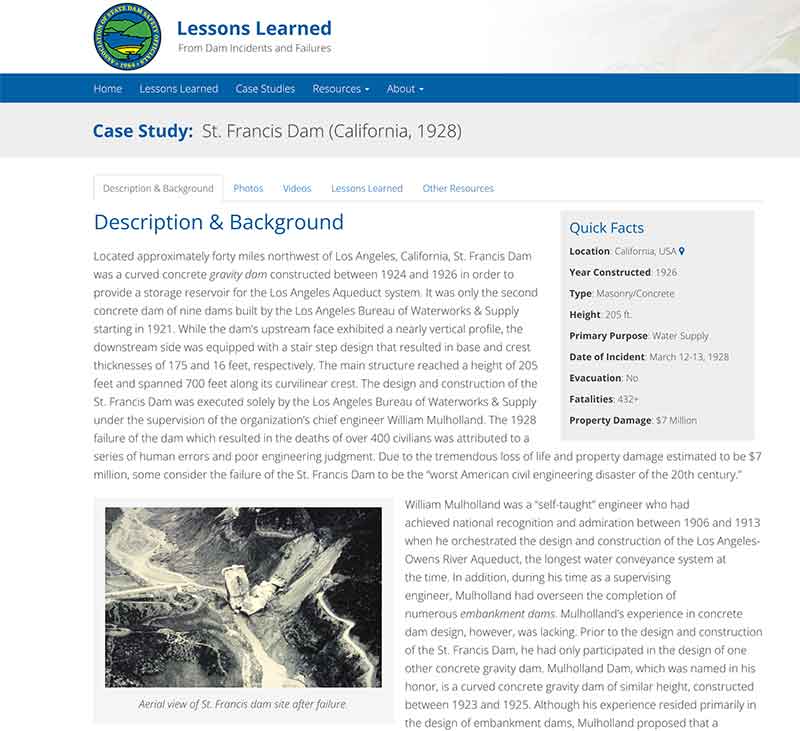1928’s St. Francis Dam Disaster
Jose Mier researches any and all information about Sun Valley, CA. Today he shines a light on a tragic event that occurred almost 100 years ago.
The St. Francis Dam Disaster of 1928 is a tragic chapter in the history of civil engineering and water management, illustrating the devastating consequences of a catastrophic dam failure. Located in the San Francisquito Canyon, approximately 40 miles north of Los Angeles, California, the St. Francis Dam was a key component of the Los Angeles Department of Water and Power’s (LADWP) water supply system. Its failure on the night of March 12, 1928, resulted in one of the deadliest disasters in California’s history, leaving a lasting impact on dam safety regulations and engineering practices.

In the early 20th century, Los Angeles experienced rapid population growth, necessitating the development of infrastructure to secure a reliable water supply. William Mulholland, the chief engineer of the LADWP, played a pivotal role in designing and overseeing the construction of the St. Francis Dam. Completed in 1926, the dam was an ambitious engineering project standing at a height of 185 feet and spanning 700 feet in length. Its purpose was to impound water from the San Francisquito Creek, creating a reservoir to meet the increasing water demands of the burgeoning city.
Despite Mulholland’s reputation as a skilled engineer, the St. Francis Dam Disaster highlighted the complex challenges and inherent risks associated with large-scale infrastructure projects. The disaster unfolded during an era when engineering practices were still evolving, and the knowledge of geological and structural factors influencing dam stability was not as advanced as it is today.
On the evening of March 12, 1928, disaster struck when the St. Francis Dam collapsed, sending a massive wall of water surging downstream. The failure occurred merely 12 hours after Mulholland had personally inspected the dam and expressed confidence in its stability. The sudden release of water unleashed a devastating flood that swept through the San Francisquito Canyon and the Santa Clara River Valley, reaching the Pacific Ocean. Entire communities were inundated, and the destruction was widespread.
The exact cause of the dam failure has been the subject of extensive investigation and debate. While no single factor can be pinpointed as the sole cause, a combination of geological, design, and construction issues contributed to the disaster. The geology of the canyon, characterized by a foundation of fractured rock and alluvial deposits, posed challenges for the dam’s stability. Additionally, the dam’s design and construction materials, including the use of questionable conglomerate rock in the dam’s core, have been identified as contributing factors.
In the aftermath of the disaster, the human toll became tragically apparent. The floodwaters claimed the lives of at least 450 people, with some estimates suggesting a higher death toll. Entire families were swept away, and communities downstream were left in ruins. The devastation extended for miles, with debris and wreckage scattered along the flood’s path. The St. Francis Dam Disaster remains one of the deadliest civil engineering failures in U.S. history.
The impact of the disaster extended beyond the immediate loss of life and property. It prompted a reassessment of dam safety regulations and engineering practices nationwide. The failure of the St. Francis Dam underscored the need for more rigorous inspections, comprehensive geological studies, and enhanced construction standards for dam projects. The tragedy led to a paradigm shift in the field of dam engineering, prompting increased awareness of the complexities involved in ensuring the stability and safety of these critical structures.
The investigation that followed the disaster revealed shortcomings in Mulholland’s decision-making and the oversight of the project. Despite his reputation as a visionary engineer, Mulholland faced public scrutiny and professional condemnation for the failure of the St. Francis Dam. The disaster had a profound impact on him personally, and he accepted responsibility for the tragedy, famously stating, “Don’t blame anyone else, you just fasten it on me. If there was an error in human judgment, I was the human.”
In the years following the disaster, the lessons learned from the St. Francis Dam failure influenced the development of dam safety regulations and engineering practices. The state of California established the Division of Safety of Dams in 1929, tasked with inspecting and regulating dams to prevent similar disasters. This marked a significant step forward in the prioritization of dam safety, and similar regulatory bodies were established in other states across the nation.
The St. Francis Dam Disaster also led to advancements in the understanding of geological and geotechnical factors affecting dam stability. The importance of conducting thorough geological investigations and implementing sound engineering practices in dam construction became evident in the aftermath of the tragedy. Engineers began incorporating lessons from the disaster into their design processes, and the field of dam safety evolved to address the complexities of working with diverse geological conditions.
The memory of the St. Francis Dam Disaster endures as a cautionary tale in engineering and water management. The tragedy served as a catalyst for ongoing advancements in dam safety, prompting continuous improvements in the design, construction, and maintenance of these critical structures. The lessons learned from the St. Francis Dam Disaster have contributed to the development of comprehensive dam safety guidelines and regulations that aim to prevent similar catastrophes in the future.
In conclusion, the St. Francis Dam Disaster of 1928 remains a pivotal moment in the history of civil engineering and dam safety. The catastrophic failure of the dam had far-reaching consequences, leading to increased awareness of the complex challenges associated with large-scale infrastructure projects. The lessons learned from the disaster continue to shape dam safety practices and underscore the importance of rigorous inspections, sound engineering principles, and comprehensive geological studies in ensuring the stability and reliability of dams. The tragedy of the St. Francis Dam Disaster serves as a somber reminder of the human and environmental costs of engineering failures and the ongoing need for continuous improvement in the field of civil engineering.